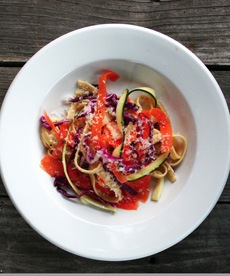TIP OF THE DAY: Enjoy Pasta More Often
 Add lots of veggies to make pasta a healthy dish. Photo courtesy Wisconsin Milk Marketing Board. |
It’s National Nutrition Month, so we’re giving some credit to a food that’s often on the “avoid” list: pasta. Jackie Newgent, RD, CDN and a consultant to Barilla pasta, has pointed out a few facts that should be of interest to any pasta lover. The good news is, you can and should incorporate pasta into your diet regularly. The only trick is to be sure that the recipe and the portion size confirm to approved guidelines for “healthy pasta.” PASTA ALONE DOES NOT ADD POUNDS Excess calories create excess fat, not healthy portions of pasta. Pasta is a good complex carbohydrate food. Several studies have shown that a balance of carbohydrates, protein and fat are crucial for maintaining a healthy weight and reducing risk of diseases. A 2009 study from Harvard School of Public Health and Pennington Biomedical Research Center found that reduced calorie diets with carbohydrates ranging from 35%-65% of the diet were equally effective for weight loss as other diet options.* |
|
|
The key to enjoying healthy pasta dishes is the recipe: The other key to a healthy pasta meal is keeping portions right-sized. A healthy portion is one to two cups of cooked pasta, the size of up to two baseballs. Use these two tricks: A one- to two-cup serving of cooked pasta is calorie friendly (about 200 calories), low in fat (about 1 gram, with no saturated or trans fats), cholesterol free and low in sodium (unless you add salt to the cooking water). You can build toward your recommended daily 47g of whole grains with whole grain pasta. Whole wheat pasta has 4g or more fiber per two-ounces of dry pasta. Check the label: Some brands, enriched with flax seeds, have double that. Pasta is a cornerstone of one of the world’s healthiest diets, the “Mediterranean Diet” of Italy, which nutritionists consider to be one of the world’s best ways to eat. |
||
|
AL DENTE PASTA KEEPS YOU FULLER LONGER According to Oldways, a non-profit organization that promotes healthy eating, and the International Pasta Organization, there’s a reason not to overcook pasta: Cooking pasta to al dente, still slightly firm, allows you to reap the full benefits of pasta’s already strong ability to increase satiety, delaying hunger pangs and providing fuel for working muscles long after meals. Due to the special protein structure of traditional pasta dough, pasta has a low to medium glycemic index (GI) value depending on cut, which means that the body digests it more slowly than most other carbohydrates. That’s true for pasta that’s made from either soft or hard wheat.† Plant based foods, including fruits, vegetables, grains and pasta, are beneficial for our bodies while also providing the smallest environmental impact.‡ |
 Chef Michael O’Boyle of Chicken Fried Gourmet does pasta the best way: 1/3 pasta, 2/3 veggies. Photo courtesy ChickenFriedGourmet.com. |
|
|
So you know what you’ve got to do: Use a dairy-free sauce, add lots of veggies and measure your pasta portion size. And enjoy pasta as often as you like. *Source: New England Journal of Medicine, 26 February 2009; 360(9):859-73. †Source: Oldways.org. ‡Source: Barilla Center for Food and Nutrition, Enabling Sustainable Food Choices The Double Pyramid.
|
||